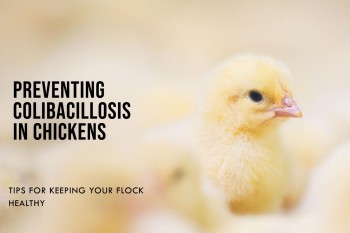Overview of Pulmonary Hypertension Syndrome (PHS) in Broiler Chickens
Definition
Pulmonary Hypertension Syndrome (PHS), often termed "Ascites Syndrome," is a pathological condition that affects broiler chickens, particularly those bred for rapid growth and high feed conversion efficiency. The syndrome is characterized by an increase in pulmonary artery pressure, which leads to hypertrophy of the right side of the heart, eventually resulting in heart failure and fluid accumulation in the abdominal cavity (ascites). The occurrence of PHS is typically linked to a mismatch between the bird's metabolic oxygen demand and its respiratory capacity to supply sufficient oxygen to the body.
Historical Context and Global Prevalence
PHS was first reported in the 1950s but has since become more prevalent with the intensification of poultry farming and genetic selection for fast-growing broilers. The syndrome is now a significant health issue worldwide, particularly in regions where broiler production is highly industrialized. Countries with large poultry industries, such as the United States, Brazil, and parts of Europe, have reported high incidences of PHS, especially during colder months when environmental stressors contribute to the condition.
While the prevalence of PHS varies depending on genetics, environmental conditions, and management practices, it is estimated that in some regions, up to 5-10% of broiler chickens are affected by the syndrome. This prevalence not only causes significant economic losses due to mortality and reduced performance but also raises welfare concerns, as affected birds suffer from significant discomfort due to respiratory distress and ascites.
Economic and Welfare Impact
PHS represents a major challenge for the poultry industry due to its financial implications. Birds that develop ascites often have reduced growth rates, poor feed conversion ratios, and increased mortality, resulting in substantial economic losses for producers. The cost associated with PHS includes not only the direct loss of affected birds but also increased veterinary care, management interventions, and reduced carcass quality due to condemnation of affected birds at processing plants.
Moreover, PHS raises serious animal welfare issues. Chickens affected by the syndrome experience difficulty in breathing, lethargy, and fluid accumulation, which can cause significant discomfort and distress. The ethical implications of raising birds in conditions where PHS is prevalent have led to increased scrutiny from animal welfare organizations and consumers alike.
2. Pathophysiology of Pulmonary Hypertension Syndrome
Cardiopulmonary Anatomy and Physiology in Broilers
To understand the development of Pulmonary Hypertension Syndrome, it is essential to first grasp the basic cardiopulmonary anatomy and physiology of broiler chickens. The avian cardiovascular system, while similar to that of mammals, has unique features that make it particularly vulnerable to pulmonary hypertension under certain conditions.
Broiler chickens have a four-chambered heart, with separate systemic and pulmonary circulations. Oxygen exchange occurs in the lungs, where deoxygenated blood from the right side of the heart is pumped through the pulmonary arteries to the lungs. Oxygenated blood then returns to the left side of the heart and is pumped to the rest of the body. In PHS, the pressure in the pulmonary arteries increases, placing excessive strain on the right ventricle, leading to hypertrophy (enlargement) and eventual failure.
Mechanisms Leading to Pulmonary Hypertension
Pulmonary Hypertension in broilers is primarily caused by an imbalance between oxygen supply and oxygen demand. The rapid growth rate of modern broiler breeds places significant metabolic demands on their bodies, requiring more oxygen to sustain their fast development. However, their respiratory system is often unable to meet this increased demand, particularly when environmental or management factors exacerbate the situation.
Several mechanisms contribute to pulmonary hypertension in broilers:
Hypoxia-Induced Vasoconstriction: When oxygen levels are insufficient, the pulmonary blood vessels constrict to divert blood flow to better-ventilated areas of the lungs. However, in cases of chronic hypoxia, this vasoconstriction can become excessive, leading to increased resistance in the pulmonary arteries and subsequent hypertension.
Right Ventricular Overload: As the pulmonary arterial pressure increases, the right ventricle of the heart must work harder to pump blood through the lungs. Over time, this leads to hypertrophy of the right ventricle, which, if sustained, results in right-sided heart failure.
Reduced Lung Capacity: Broilers have a relatively limited lung capacity compared to their rapid growth and metabolic demands. This reduced capacity for gas exchange can predispose birds to hypoxia, particularly when environmental stressors such as cold temperatures or high altitudes are present.
Right Ventricular Hypertrophy and Heart Failure
One of the hallmark features of PHS is right ventricular hypertrophy, which occurs as a compensatory mechanism to cope with increased pulmonary artery pressure. Over time, however, the right ventricle becomes unable to sustain this increased workload, leading to decompensated heart failure. At this stage, the heart is no longer able to pump effectively, causing fluid to back up into the veins and eventually accumulate in the abdominal cavity, resulting in ascites.
Ascites Formation and Its Progression
Ascites, the abnormal accumulation of fluid in the abdominal cavity, is a direct consequence of right-sided heart failure. As the heart fails, venous pressure increases, leading to leakage of fluid from the blood vessels into the surrounding tissues. This fluid accumulation is initially seen in the peritoneal cavity and may eventually spread to other parts of the body, including the liver and lungs. Birds with advanced ascites exhibit significant abdominal distension and respiratory distress, ultimately leading to death if not managed promptly.
3. Etiology and Contributing Factors
Genetic Predisposition
Modern broiler chickens have been selectively bred for rapid growth and efficient feed conversion. However, this genetic selection has inadvertently increased the susceptibility of broilers to PHS. Birds with larger muscle mass, particularly those with rapid breast muscle development, require more oxygen to sustain their growth. However, their cardiopulmonary system may not be able to keep pace with this increased demand, predisposing them to pulmonary hypertension and ascites.
Research has shown that certain genetic lines of broilers are more prone to developing PHS, suggesting that the condition is heritable. Genetic selection programs aimed at reducing the incidence of PHS have had some success, but balancing growth performance with cardiovascular health remains a challenge for breeders.
Rapid Growth Rate and Metabolic Demands
The rapid growth rate of broilers, particularly during the first few weeks of life, places tremendous metabolic demands on their bodies. This increased metabolic rate requires more oxygen to fuel cellular processes, but the birds' cardiopulmonary system may not be able to meet this demand, leading to hypoxia and subsequent pulmonary hypertension.
In broilers, the demand for oxygen peaks during periods of rapid growth, typically between 4 to 6 weeks of age. If the bird's respiratory system cannot supply sufficient oxygen, the resulting hypoxia triggers pulmonary vasoconstriction and hypertension, setting the stage for PHS.
Environmental Stressors (Temperature, Altitude, Oxygen)
Temperature Extremes: Environmental conditions, particularly temperature, play a critical role in the development of Pulmonary Hypertension Syndrome. Cold stress is one of the most significant environmental triggers for ascites in broilers. During colder months, broiler farms often see a spike in the incidence of PHS. When exposed to low temperatures, birds expend more energy to maintain body heat, leading to increased oxygen demand. Additionally, cold temperatures can compromise the respiratory efficiency, resulting in reduced oxygen intake and subsequent hypoxia, which predisposes birds to pulmonary hypertension.
Conversely, heat stress can also exacerbate the condition by causing respiratory alkalosis due to excessive panting, which reduces the levels of carbon dioxide in the blood. This leads to vasoconstriction in the pulmonary arteries and can result in elevated pulmonary pressure. Thus, both cold and heat extremes must be meticulously managed in broiler housing.
High Altitude: Altitude has a profound impact on oxygen availability, and farms located at higher altitudes (above 1500 meters) are more likely to experience higher incidences of PHS. At these elevations, the partial pressure of oxygen in the air is lower, which reduces the amount of oxygen available to birds. This hypoxic condition triggers compensatory mechanisms such as pulmonary vasoconstriction and right ventricular hypertrophy, both of which can lead to the development of pulmonary hypertension and ascites.
Oxygen Levels: Suboptimal ventilation in broiler housing can lead to increased levels of ammonia and carbon dioxide, contributing to respiratory distress. Ammonia, a by-product of uric acid breakdown in litter, can irritate the respiratory tract and reduce the lung’s ability to efficiently exchange gases, further compounding hypoxia. Proper ventilation is crucial to maintain appropriate oxygen levels and prevent respiratory compromise.
Nutritional Imbalances
Nutrition plays a fundamental role in maintaining the health and growth of broiler chickens. However, inappropriate or imbalanced nutrition can predispose birds to developing PHS. High-energy diets designed to support rapid growth can increase metabolic oxygen demands, putting additional strain on the cardiovascular and respiratory systems.
Certain nutrients are particularly relevant to the pathogenesis of PHS:
Protein Levels: High protein diets can increase metabolic heat production and oxygen consumption, which may exacerbate the risk of ascites under specific environmental conditions.
Fat Content: Diets high in fat have been observed to help reduce the incidence of PHS. Fat supplementation lowers the overall metabolic heat production of the bird, reducing oxygen demand and heat stress. Thus, balanced fat inclusion in the diet is often used as a preventive strategy.
Salt (Sodium Chloride): Excessive dietary sodium can lead to water retention and increased blood volume, which in turn places additional strain on the cardiovascular system, making birds more susceptible to pulmonary hypertension.
Antioxidants: The inclusion of certain antioxidants, such as vitamin E and selenium, has been shown to mitigate oxidative stress, which can contribute to endothelial dysfunction in the pulmonary arteries. These supplements are sometimes used to reduce the impact of PHS.
Infectious Agents and Respiratory Conditions
While the primary cause of PHS is non-infectious, respiratory diseases can act as exacerbating factors. Infectious bronchitis (IB), a highly contagious viral disease, is known to damage the respiratory system, leading to inefficient oxygen exchange. Similarly, Escherichia coli infections (colibacillosis) and Mycoplasma gallisepticum can further compromise respiratory function, increasing the risk of hypoxia and thus contributing to the development of PHS.
Respiratory infections impair the ability of the lungs to properly oxygenate the blood, forcing the cardiovascular system to work harder, leading to pulmonary hypertension in vulnerable birds.
4. Clinical Manifestations of Pulmonary Hypertension Syndrome
Early Signs and Subclinical Indicators
The early stages of Pulmonary Hypertension Syndrome are often subclinical, with few overt signs until the disease has progressed. Subclinical birds may exhibit reduced feed intake and slower growth rates compared to their healthy counterparts. Early signs that a broiler is developing PHS include:
- Increased lethargy
- Mild respiratory distress, particularly when birds are active
- Reduced activity levels in the flock
- Cyanosis (bluish discoloration) of the comb and wattles, indicating poor oxygenation
Veterinarians and poultry managers should carefully monitor for these subtle signs, particularly in flocks with known risk factors such as genetic predisposition or environmental stressors.
Acute vs. Chronic Ascites
As PHS progresses, birds may develop ascites, which can be classified as acute or chronic. Acute ascites often occurs suddenly, with rapid onset of severe symptoms. Birds may die unexpectedly without exhibiting prolonged signs of illness. In contrast, chronic ascites is more insidious, with affected birds slowly accumulating fluid over several weeks.
Acute Ascites Symptoms:
- Sudden death
- Severe respiratory distress, with gasping and open-mouth breathing
- Distended abdomen due to fluid accumulation
- Cyanosis of comb and wattles
Chronic Ascites Symptoms:
- Gradual development of abdominal distension
- Reduced activity and feed intake
- Mild to moderate respiratory distress
- Poor growth performance
Physical Exam Findings
Upon physical examination, birds with ascites typically exhibit a distended abdomen, which feels tense due to the accumulation of fluid. Palpation of the abdomen may reveal the presence of free fluid, and auscultation may reveal muffled heart sounds, indicative of right ventricular hypertrophy. Birds in more advanced stages of ascites may show severe respiratory distress, with audible crackles or wheezes upon lung auscultation.
Postmortem Findings
Postmortem examination is critical for confirming the diagnosis of PHS. Key findings include:
Right Ventricular Hypertrophy: The right ventricle of the heart is often significantly enlarged, sometimes occupying a disproportionately large portion of the heart.
Ascites: Clear, yellowish fluid is typically found in the peritoneal cavity. In some cases, the fluid may become more viscous or contain fibrin strands.
Pulmonary Changes: The lungs may appear congested, with evidence of edema.
Liver Enlargement: In birds with advanced ascites, the liver may also become enlarged and congested, often with visible surface hemorrhages.
5. Diagnosis of Pulmonary Hypertension Syndrome
Laboratory Investigations
While clinical and postmortem findings can provide a strong indication of PHS, laboratory investigations are often needed to confirm the diagnosis and rule out other conditions. Common diagnostic tests include:
Blood Gas Analysis: A decrease in arterial oxygen levels (hypoxemia) and an increase in carbon dioxide levels (hypercapnia) are typical findings in birds with PHS.
Complete Blood Count (CBC): Hematological changes, such as an increase in packed cell volume (PCV) or hematocrit, may suggest chronic hypoxia and compensatory polycythemia (increased red blood cell production).
Serum Biochemistry: Elevated serum levels of lactate dehydrogenase (LDH) and aspartate aminotransferase (AST) can indicate muscle damage, including cardiac muscle damage due to right ventricular overload.
Radiographic and Ultrasonographic Diagnosis
Imaging techniques such as radiography and ultrasonography can provide valuable insight into the extent of PHS. Radiographs may show:
- Enlarged cardiac silhouette, indicating right ventricular hypertrophy
- Pulmonary edema or pleural effusion
- Liver enlargement
Ultrasonography can be used to assess the degree of ascites and measure the thickness of the right ventricular wall.
Postmortem Examination and Histopathology
Postmortem examination remains the gold standard for diagnosing PHS. In addition to the gross findings described above, histopathological examination of the heart may reveal hypertrophy of the right ventricular myocardium, while the lungs may show evidence of congestion and edema. Liver pathology may also reveal centrilobular congestion and fatty infiltration, both secondary to right-sided heart failure.
Differential Diagnosis
Several conditions may present with similar clinical signs to PHS, so it is essential to rule out alternative diagnoses. Differential diagnoses include:
- Infectious bronchitis (causing respiratory distress)
- Avian colibacillosis (leading to septicemia and ascites)
- Mycoplasmosis (a respiratory disease that can mimic the signs of PHS)
- Hepatic diseases causing fluid accumulation in the abdomen
6. Management and Control Strategies
Genetic Selection and Breeding Strategies
One of the most effective long-term strategies for controlling PHS is selective breeding. Genetic selection for birds with improved cardiopulmonary function, without compromising growth rate and feed conversion efficiency, has been a focus of broiler breeding programs. Research has shown that birds with smaller hearts relative to their body size, or those with better vascular capacity, are less likely to develop PHS. Breeding programs continue to aim at reducing susceptibility to ascites by selecting birds with superior cardiovascular health.
Environmental Management (Ventilation, Temperature Control)
Environmental management plays a key role in reducing the incidence of PHS. Proper ventilation systems that ensure adequate oxygen levels and remove excess ammonia and carbon dioxide are crucial for maintaining respiratory health. Temperature control is also critical, as extremes in temperature, particularly cold stress, have been closely linked to the development of ascites.
Nutritional Interventions
Adjusting the nutritional profile of broiler diets can help reduce the incidence of PHS. Dietary strategies include:
Reducing Metabolic Heat Production: By adjusting the energy-to-protein ratio in the diet and including fat as an energy source, metabolic heat production can be minimized, thereby reducing oxygen demand.
Use of Antioxidants: Supplementing the diet with antioxidants such as vitamin E, selenium, and beta-carotene has been shown to reduce oxidative stress, which may play a role in the pathogenesis of PHS.
Balancing Electrolytes: Proper management of sodium, potassium, and chloride levels in the diet can help prevent fluid imbalances that may exacerbate ascites.
Use of Pharmaceuticals and Feed Additives
Various pharmacological interventions have been explored to mitigate the effects of PHS. These include:
Diuretics: These can be used to reduce fluid accumulation in birds with ascites, although their use is typically limited to valuable breeding stock rather than commercial broilers due to cost considerations.
Vasodilators: Agents such as nitric oxide donors have been investigated for their potential to reduce pulmonary artery pressure by dilating blood vessels.
Feed Additives: The inclusion of feed additives such as carnitine and taurine has been explored for their cardioprotective effects, although more research is needed to confirm their efficacy.
7. Preventive Measures
Early Detection Programs
Early detection is critical for managing PHS effectively. Monitoring flock behavior, growth rates, and environmental conditions can help identify birds at risk of developing ascites before the condition progresses. Pulse oximetry and blood gas analysis can be used to detect subclinical hypoxia in flocks, allowing for early intervention.
Flock Monitoring and Management Practices
Maintaining meticulous records of flock performance, environmental conditions, and health parameters can help identify trends associated with the development of PHS. Regular monitoring of oxygen levels, temperature, and ventilation is crucial for reducing the incidence of ascites in broiler flocks.
Welfare Considerations
The welfare implications of PHS are significant, as birds with the condition suffer from respiratory distress and fluid accumulation, which can cause considerable discomfort. Implementing welfare-friendly practices, such as providing adequate ventilation and preventing overcrowding, is essential for minimizing the impact of PHS on broiler flocks. Additionally, genetic selection for birds with lower susceptibility to PHS can help address welfare concerns in the long term.
8. Future Perspectives and Research Directions
Advances in Genetic Research
Genomic selection is increasingly being used to identify genetic markers associated with resistance to PHS. Advances in molecular genetics and biotechnology offer promising avenues for improving the cardiovascular health of broiler chickens. Gene-editing technologies, such as CRISPR, may also play a role in developing broilers with enhanced resistance to pulmonary hypertension, although ethical considerations surrounding genetic modification must be carefully weighed.
New Diagnostic and Therapeutic Approaches
The development of non-invasive diagnostic tools, such as wearable sensors that monitor heart rate and oxygen saturation in real-time, may provide new ways to detect PHS early. Furthermore, research into novel pharmacological treatments, such as specific vasodilators and anti-inflammatory agents, could offer new therapeutic options for managing PHS in broilers.
Pulmonary Hypertension Syndrome (Ascites) represents a significant challenge for both the poultry industry and veterinarians alike. The multifactorial nature of the disease, driven by genetic, environmental, nutritional, and infectious factors, requires a comprehensive approach to management and prevention. By focusing on genetic selection, optimizing environmental conditions, and improving flock nutrition, veterinarians can help reduce the incidence of PHS in broiler flocks. Early detection and proactive management are essential for minimizing economic losses and ensuring the welfare of broiler chickens.
While significant progress has been made in understanding and managing PHS, continued research is needed to develop new diagnostic tools, genetic improvements, and pharmacological interventions. With a combination of current best practices and future innovations, the poultry industry can continue to mitigate the impact of Pulmonary Hypertension Syndrome on broiler health and production.

















